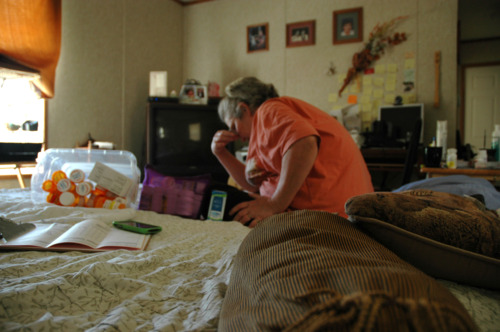
By Ariella Cohen, The Lens staff writer |
More than six years after FEMA provided displaced Hurricane Katrina victims with trailers that were later revealed to be toxic, early tests suggest that dangerously high levels of formaldehyde linger in the more than 130,000 units still in use.
An air quality test done last month in a FEMA trailer housing Hurricane Katrina victims in Mississippi showed levels of the carcinogen that exceeded levels deemed safe by the federal government. The test, done by University of Oxford researcher Nick Shapiro, indicated a level of exposure of 105.6 parts per billion within the trailer, which was sold by FEMA in 2008 to a retired Mississippi couple who had lost their home to Katrina and could not afford to rebuild.
Like thousands of trailer residents who have come forward over the past six years, Charles and Barbara Syrie say the formaldeyde-laced trailers have made them ill.
“We have symptoms of exposure,” Charles Syrie said. “Headaches. My wife Barbara has a raspy, raspy voice most of the time. We have muscle aches. Two years ago, Barbara had perfect teeth. Now she can pretty much break them off with her fingers.”
Though FEMA does not have an official limit for safe exposure to formaldehyde, the level registered in the Syrie’s trailer is high by all measures and far in excess of the 16 parts per billion, the level that was declared acceptable under agency standards established in 2008 in response to lawsuits filed in the wake of Katrina. For context, the average formaldehyde level in manufactured homes ranges from 15.5 ppb to 36.3 ppb, according to the U.S. Centers for Disease Control and Prevention, which, along with the U.S. Department of Health, believes formaldehyde causes cancer in instances of chronic exposure. Studies have shown that chronic exposure at the same 100 ppb level seen in the Mississippi trailer can cause health effects in sensitive individuals, the CDC states in its own research materials. Likewise, the World Health Organization has set its guideline for formaldehyde in non-occupational settings at 100 ppb for 30 minutes.
“I wish we could leave, but we live on Social Security, on a fixed income,” Syrie said. “We can’t afford to go anywhere else.”
The Lens has teamed up with University of Oxford researcher Shapiro to track down more of FEMA trailers being used as permanent homes, test their air quality and learn more about how Americans are faring as they make lives in Katrina’s government-issued, chemical-laced overstock.
As The Lens reported in May, more than 130,000 FEMA trailers put back on the open market by the federal government are popping up in disaster zones and other places where people are desperate for low-cost housing.
In towns hit hard by the foreclosure crisis, Katrina’s leftovers can be seen in trailer parks and discount dealerships.
In Louisiana and Mississippi, a sluggish economy has kept Katrina victims like the Syries from rebuilding homes and moving out of the cramped, contaminated quarters they once thought temporary.
Over the next few months, The Lens and Shapiro will test more of these trailers using equipment donated by Prism Analytical Technologies, a Michigan-based manufacturer of home air testing equipment. The Syrie trailer in Picayune, Mississippi was the first tested by Shapiro. You can read a first-hand account of Shapiro’s experience tracking and testing FEMA trailers at his blog, http://boratory.org/.
The Syries bought their trailer from FEMA because they could not afford to move following Katrina. The sales price was $5. The federal agency tested it for formaldehyde and found it safe for habitation, they say. Yet after years of experiencing mysterious health problems and watching three pet dogs die of cancer, the trailer inhabitants decided it was time for another test. “Everyone – the vet, our doctors—was saying it’s the formaldehyde making us sick,” Syrie said.
The potential toxicity of FEMA trailers quickly became a hot topic nationally when the government rushed the low-cost temporary housing units to Gulf Coast residents displaced by Hurricanes Katrina and Rita in 2005. Soon after the trailers appeared in the disaster-stricken region, inhabitants began to complain of persistent sickness – headaches, nausea, burning, watery eyes and bloody noses, chronic respiratory problems. Soon enough, the complaints were tied to the formaldehyde present in the manufactured particleboard and plywood used to quickly and cheaply manufacture the small, unventilated temporary housing units procured by FEMA in the immediate aftermath of the storm. After months of debate about the units’ safety, residents banded together to test the air quality of their trailers. Eventually, lawyers began to file class-action lawsuits against trailer manufacturers and FEMA, which procured and paid for the contaminated units.
While the litigation continues to wind through the courts, the fracas has resulted in policy changes forbidding the sale or use of the trailers as permanent housing. Thousands of trailers went into storage. FEMA encouraged people to give up those still on the market, even creating a program so that people could sell units back to the federal government. Officials vowed never again to use the contaminated model. And, as it goes in the seven-minute news cycle, the issue all but faded from national attention.
Unfortunately, the saga of these so-called toxic tin cans wasn’t over. The trailers had been built at a cost of $1.7 billion, plus $75 million a year to store and maintain. To partially recoup the investment, the U.S. General Services Administration sold more than 130,000 trailers on the open market, with a red-lettered bumper sticker warning that they could not be used as permanent housing and a threat of legal retaliation against resellers.
“We thought we were getting a deal,” Syrie said. “It turns out we’re just stuck.”
Have you seen, lived in, bought or sold a FEMA trailer? Know someone who has? The Lens and American Public Media want to hear your story. Share your insights here.



